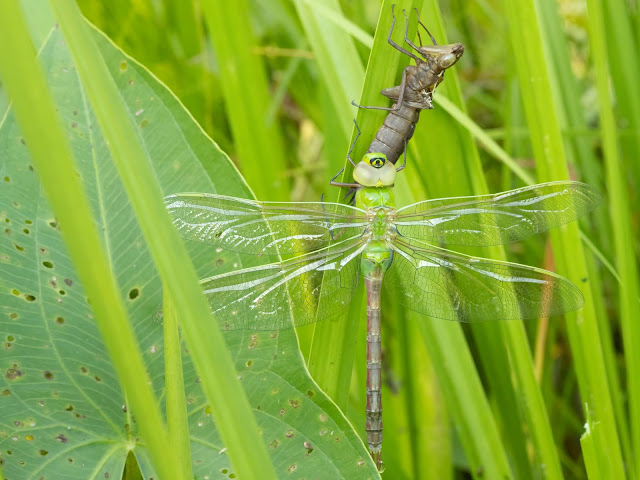The King of June Emerges! (in July)
 |
| A Freshly Emerged Common Green Darner, Homer Lake Wetland, July 2nd 2021, 5:40am |
I came to the wetland early on Friday July 2nd and sure enough, as I suspected, common green darners were emerging as adult dragonflies. King of June? Yes, the scientific name for the common green darner is "Anax junius," which means "King of June." However, as noted elsewhere in this blog, these critters migrate north and arrive here in Central Illinois as early as late March and we will see them all the way through September at least, so perhaps a better name for them might be "King of Summer" (however you say that in Greek or Latin).
Clearly though, the one pictured above was not a migrant but was on the morning of July 2nd in the process of emerging from the pond. In addition I found the exuviae (the shed exoskeletons of the last nymph stage before the adult emerges, the brown shell that the dragonfly above and below is still clinging to, exactly like the shells that adult cicadas leave behind) of eight additional darners around the edges of the pond. No doubt I missed some as well. The one pictured above and below seemed to be running behind schedule a bit since normally darners have flown off to the woods before the sun rises. This was the only teneral (newly emerged adult) darner that I found.
The common green darners emerging from the pond now are most likely the offspring of the early migrants that arrived at the wetland at the end of March and the beginning of April. This year I saw the first male common green darners patrolling the wetland on March 22nd and the first pair of common green darners laying eggs together ("ovipositing") on April 6th.
If you've been following the blog posts (and if not, welcome aboard!), you will know that early in June we witnessed the emergence of another dragonfly species, the ruby meadowhawk. There is another meadowhawk species also emerging at the wetland now, the blue-faced meadowhawk. Apart from the possibility of another meadowhawk species being present, it is quite likely that these three dragonfly species, the two meadowhawks and the common green darner are the only dragonflies we will see actually emerge as adults from the wetland this season. Why? Because there was no water in the wetland for four months late last summer and fall, so in all likelihood, all other immature dragonflies that would have emerged this year died during the dry spell. The meadowhawk eggs, however, were laid AFTER the wetland was dry and waited for the winter and spring rains to hatch. The darner eggs, as we have noted, were not laid until the migrants arrived in late March and April and water was already present. Other dragonfly species currently breeding at the wetland have almost certainly started too late for their young to emerge before the wetland goes dry toward the end of the summer... but we shall see.
Another remaining question, though, is whether or not common green darner eggs laid in the area of the wetland after it was dry, just as the meadohawk eggs were, might possibly have survived and also be a part of the current darner emergence. Darner eggs are not known to survive winter or long periods of drought, but neither is it known for certain that they do not. This is an open question I am interested in investigating further if possible.
 |
| The Same Common Green Darner with Spread Wings, Homer Lake Wetland, July 2nd 2021, 7:57am |



Comments
Post a Comment